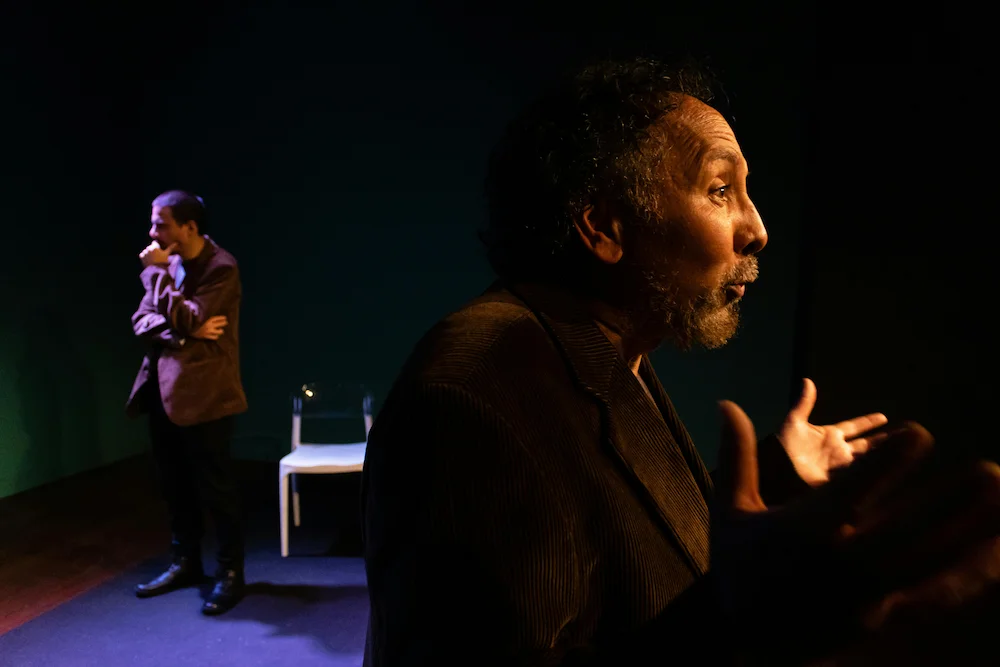What Is Naturalistic Dialogue and Why It Matters?
by WriteSeen
Naturalistic dialogue is how speech flows in real life, complete with its stops, starts, and subtle undertones. It is a technique in playwriting that mirrors everyday conversations to create believable characters and situations.
Crafting this type of dialogue involves engaging informal language, pauses, and interruptions while maintaining clarity. It draws in audiences by blending spoken words with the unspoken thoughts and emotions—known as subtext. For playwrights, the goal is authenticity balanced with storytelling. Support your writing with real-world observations, focus on character, and avoid common pitfalls like excessive slang or filler. Unlock your creativity and strengthen your story through well-written, naturalistic dialogue.
Key Characteristics of Naturalistic Dialogue
Exploring naturalistic dialogue involves replicating the ease and unpredictability of real conversation. The aim here is simple yet challenging: to capture how people actually speak, with all their quirks, repetitions, and spontaneity. This approach transforms dialogues into believable exchanges that resonate deeply with audiences. Let's break down the essential features:
-
Informal Language: Catch the nuances of everyday talk. Characters speak just like people do in real life, using informal speech rather than polished prose. This pulls the audience into the scene, making the dialogue relatable and engaging.
-
Pauses and Interruptions: Real-life conversations aren't scripted. They involve pauses, interruptions, and overlaps. Adding these elements into your script enhances its realism—help audiences feel like they're witnessing an authentic exchange.
-
Subtextually Layered: Natural dialogue is more than just words spoken aloud. The actual meaning often lies beneath the surface. The unspoken thoughts and hidden emotions drive the conversation forward, adding depth to each exchanged line.
-
Purposeful Yet Genuine: Here’s the balancing act—keeping dialogue authentic without sacrificing clarity and direction. Every line should serve the story, even while mimicking real-world speech patterns.
Remember: Authentic dialogue paints a vivid picture of your characters and their world. It’s a cornerstone of compelling playwriting, inviting audiences to connect more intensely with your story.

The Importance of Subtext in Naturalistic Dialogue
Subtext is the unseen force that drives compelling naturalistic dialogue. It’s the layer beneath the spoken words, where true intentions and emotions lie. For playwrights, mastering subtext is crucial for crafting scenes that resonate with depth and complexity.
In real conversations, much of what individuals truly mean isn't spoken directly. Characters might say one thing but mean another, revealing a gap between dialogue and emotion. This is where subtext thrives, offering subtlety and richness to character interactions. It’s the secret to "showing, not telling." Your audience will engage more deeply as they interpret the underlying messages themselves.
Subtext reveals conflicts, desires, and relationships without overt exposition. This empowers actors to deliver performance nuances, as they convey the subtext through body language, tone, and pause. The play becomes a multisensory experience, enriched by these unspoken exchanges.
Every word has purpose—a layer of meaning and intensity beneath the obvious words. Hooking the audience through clever subtextual play heightens their emotional investment in your narrative. Use it effectively to create textured, compelling characters who speak volumes with every line.
Techniques for Writing Naturalistic Dialogue in Plays
Crafting naturalistic dialogue demands a precise blend of observation, creativity, and intuition. The goal is to echo the rhythm of genuine conversation while maintaining narrative clarity. Let’s delve into some compelling techniques to achieve this balance:
-
Listen and Observe: Real-world conversation is a goldmine for dialogue inspiration. Immerse yourself in different environments to capture subtle details—accents, vernacular, and cadence—that make conversations authentic.
-
Character Voices: Each character should possess a unique voice. Develop these voices by understanding their backgrounds, motivations, and emotional drives. Consistency in their language will make your characters believable and multidimensional.
-
Rework and Refine: Writing dialogue is an ongoing process of refinement. Initial drafts capture raw ideas, but revisions clarify character intentions and interactions. This iterative process sharpens each line, ensuring it is true to life yet purposeful.
-
Collaborate with Actors: Actors bring dialogue to life. Rehearsals with performers serve as a testbed to see how naturally your dialogue flows. Be open to their interpretations and adjustments, turning collaborative insights into dialogue that shines on stage.
Effective dialogue serves the scene, advancing the plot and deepening understanding of your characters. Prioritize natural flow and emotional truth over elaborate speeches to create vivid theatrical encounters.
Pitfalls to Avoid in Naturalistic Dialogue
Navigating the complexities of naturalistic dialogue requires you to avoid common missteps that can derail authenticity. Awareness of these pitfalls throughout your writing process will help you maintain dialogue that resonates.
-
Overusing Slang or Filler Words: While natural conversations use informal language, over-relying on slang or fillers can clutter dialogue. Use these elements sparingly to enhance realism without clouding communication.
-
Going off Tangent: It's easy to get lost in the details. Ensure every line contributes to character development or plot progression. Extraneous dialogue can dilute the focus and disengage your audience.
-
Excessive Exposition: Real conversations rarely include detailed summaries of past events. Incorporate essential information through actions and reactions, keeping the audience engaged without overwhelming them with backstory.
-
Inconsistent Character Language: To maintain credibility, each character must have a consistent voice. Inconsistencies in speech patterns can confuse audiences and weaken the character’s believability.
-
Ignoring Pacing: Real conversations ebb and flow. Maintain a dynamic rhythm by balancing quick exchanges with pauses or beats, ensuring the dialogue neither rushes nor lags.
Avoiding these pitfalls ensures your naturalistic dialogue remains sharp, purposeful, and engaging. The audience is here for the journey and each word counts in enhancing their experience.

Enhancing Character Development through Naturalistic Dialogue
Naturalistic dialogue goes beyond mere conversation—it's a powerful tool for defining and deepening your characters. Through authentic exchanges, their personalities, values, and motivations unfold, making them relatable and compelling to your audience. Here’s how you can leverage natural dialogue for character development:
-
Unique Voices Reveal Personality: Each character’s dialogue should feel distinct. Use language and tone that reflect their individual experiences, backgrounds, and social status. This contrast helps to bring out their traits and subtleties, letting audiences understand who they are at their core.
-
Subtly Expose Backstory: Dialogue can hint at past experiences and personal history without heavy exposition. Place clues within natural discussions, allowing the audience to piece together a character's prior events and relationships over time. This creates intrigue and depth.
-
Show Growth Over Time: As the narrative progresses, let dialogue illustrate change. Shifts in language and interaction can vividly capture evolving relationships and personal transformations, highlighting character arcs effectively within the storyline.
-
Use Dialogue to Explore Relationships: Conversations between characters reveal dynamics and tensions. Through dialogue, we see alliances form, conflicts emerge, and loyalties tested. These interactions enrich the plot and offer new layers to explore.
By focusing on these aspects, your characters won’t just speak—they’ll resonate with authenticity and depth, inviting audiences to invest emotionally.
Analyzing Exemplary Naturalistic Dialogue in Theatre
Studying the dialogue of celebrated plays provides invaluable insights into what truly works. Many playwrights have mastered this craft, and dissecting their work offers lessons on making dialogue feel intuitive yet powerful.
Famed Dialogues Examples:
-
Anton Chekhov: Known for writing dialogue that reflects the emotional complexity of everyday life, Chekhov’s plays present conversations that seem casual but are rich with layered meaning.
-
Arthur Miller: His characters’ dialogues are grounded in realism, reflecting societal pressures and personal struggles. Miller’s ability to capture the cadence of everyday speech adds weight to his narratives.
-
Tennessee Williams: Williams’ dialogue is evocative, capturing regional nuances and emotional undercurrents. It helps to reveal deep-seated desires and tensions between characters.
Key Insights: By analyzing these works, note how these playwrights employed dialogue to advance themes and character development. Adapt their strategies into your writing to step into the audience's perspective and craft dialogue that resonates.
Workshop Exercise for Playwrights: Crafting Naturalistic Dialogue
Working on your dialogue skills requires practice, and structured exercises can refine your ability to craft believable conversations. Here's an effective workshop exercise to hone your craft:
-
Real-World Observation: Spend time in a public space, making mental notes of real conversations. Pay attention to speech patterns, pauses, and interruptions. Write a scene incorporating those elements, focusing on capturing authenticity.
-
Character Monologues: Assign each character a brief monologue to express a hidden desire or fear. This exercise can help clarify each character’s voice and highlight unique traits that need to come through in dialogue exchanges.
-
Partnered Improvisation: Pair up with another writer or actor to improvise a scene. Without strict scripts, dialogue flows naturally, revealing organic rhythms and unexpected turns. Adapt what feels genuine into your writing.
Such exercises push you to explore dialogue from new angles, gaining the skills to write conversations that sound off-the-cuff yet carry story forward.
Conclusion
Naturalistic dialogue breathes life into characters by reflecting the rhythm and complexity of real speech. Through informal language, subtext, and purposeful pauses, it captures authenticity while still advancing the story. When done well, it draws the audience into the emotional landscape of a scene without ever feeling forced or artificial.
Mastering this craft involves observation, refinement, and a deep understanding of character. Avoiding common pitfalls like overuse of slang or inconsistent voice is just as important as developing layered subtext and unique vocal patterns. Great dialogue is rewritten, rehearsed, and shaped with care—until it sounds like people truly speaking, not just performing.
Whether you're just starting or refining your skills, keep practicing with real-world exercises and studying exemplary playwrights. Join a community where your work can evolve, gain feedback, and reach collaborators who care about story as much as you do. Join WriteSeen today to connect with fellow creatives and elevate your dialogue-driven storytelling.
TAGS